Eubalaena glacialis (North Atlantic right whale) 1 (30986325841)
Eubalaena glacialis (Müller, 1776) - North Atlantic right whale skeleton (real). (public display, North Carolina Museum of Natural Sciences, Raleigh, North Carolina, USA)
Mammals are the dominant group of terrestrial vertebrates on Earth today. The group is defined based on a combination of features: endothermic (= warm-blooded), air-breathing, body hair, mother's milk, four-chambered heart, large brain-to-body mass ratio, two teeth generations, differentiated dentition, and a single lower jawbone. Almost all modern mammals have live birth - exceptions are the duck-billed platypus and the echidna, both of which lay eggs.
Mammals first appear in the Triassic fossil record - they evolved from the therapsids (mammal-like reptiles). Mammals were mostly small and a minor component of terrestrial ecosystems during the Mesozoic. After the Cretaceous-Tertiary mass extinction at 65 million years ago, the mammals underwent a significant adaptive radiation - most modern mammal groups first appeared during this radiation in the early Cenozoic (Paleocene and Eocene).
Three groups of mammals exist in the Holocene - placentals, marsupials, and monotremes. Other groups, now extinct, were present during the Mesozoic.
Whales are members of Order Cetacea, which includes the dolphins and porpoises. Cetaceans have intermediate- to very large-sized bodies that are streamlined (cigar-shaped) and have a thick blubber layer for heat insulation purposes. They are evolutionarily derived from terrestrial mammals that had four legs. The former front legs are now flippers. The hind legs are highly reduced and non-functional in whales. The skull is elongated, with one or two blowholes atop the head. The tail is horizontally-oriented, unlike the vertically-oriented caudal fin ("tail") of a fish. Vertical movement of a whale's tail provides propulsion. Whale bodies have a soft outer skin layer with almost no hair - this improves water flow around the body.
Whales are famous for being deep and long divers. Sperm whales can dive to over 9,200 feet deep. Northern bottlenose whales can hold their breath for over two hours. Unlike humans, whales have evolved mechanisms for coping with diving diseases such as nitrogen narcosis and decompression sickness.
Cetaceans are subdivided into two groups - the odontocete whales and the mysticete whales. The odontocetes are the toothed whales and include the sperm whale, killer whale, dolphins, and porpoises. Mysticete whales are the baleen whales - they include the blue whale, finback whale, humpback whale, gray whale, right whale, minke whale, sei whale, etc. Baleen whales have much larger bodies than toothed whales and have two blowholes atop the head. They eat low on the food pyramid - their dominant food is krill, which is an abundant, small crustacean (Animalia, Arthropoda, Crustacea). Baleen whales usually feed near the surface. Instead of having teeth, these animals have baleen - parallel rows of keratin plates hanging down from the upper jaw. Baleen is used to concentrate small prey and separate them from seawater. Individual baleen plates can be up to 14 feet long.
Right whales are the rarest of the great whales - 3 species exist. The skeleton shown above is the North Atlantic right whale.
From museum signage: "Right whales are easy to identify - if you're lucky enough to spot what may be the rarest of all great whales. They have short flippers and their faces are covered with hard callosities. Just as every person has a unique fingerprint, every right whale has a unique pattern of callosities.
Right whales may once have numbered as many as 300,000. Because their slow speed and great size - up to 60 feet and 100 tons - made them easy targets for whalers, their numbers plummeted. Right whales have been protected internationally since 1937, but their population remains low.
Northern right whales migrate between the cold waters of the northern Atlantic and the warm waters of the Gulf of Mexico. They feed in the north and breed in the south.
When exhaling through their blowholes, right whales have a characteristic V-shaped spray. Other baleen whales have much more diffuse sprays.
The crusty bonnet of callosities on a right whale's head is unique to the species. Callosities, which are like hardened calluses, may be used by males to compete for females.
Whale lice live in the crusty callosities. Each species of whale has its own species of lice.
Northern right whales are skim feeders. Swimming along the ocean surface, the whales open their mouths wide and catch small prey at the surface in their long baleen plates.
It takes about 4,000 plankters to fill a teaspoon. An average adult whale eats about two tons - 768,000 teaspoons - of plankton per day.
To early whalers, right whales were the "right" whales to hunt. These whales swim slowly and travel close to shore. When dead, they float. They were valued for their large quantities of blubber, which was rendered into soap and fuel oil, and for their baleen, strong, flexible plates in their mouths, which was used to make buggy whips and corset stays.
In the 1800s, North Carolinians living on the coast used whaling to supplement income. Mayflower, a 50-foot northern right whale, brought in 40 barrels of oil and 700 pounds of baleen, or "whalebone", to the crew that landed it.
On display since the 1890s, Mayflower's skeleton was one of the first specimens acquired by the museum. Today, northern right whales are listed as endangered species; fewer than 300 may now survive in the North Atlantic Ocean.
On May 4, 1874, a handful of men in small boats engaged in a six-hour battle with a large northern right whale. She dragged the Red Oar crew, Josephus Willis and his five sons, six miles out to sea before succumbing to harpoon and whale gun. The crew named her "Mayflower" in honor of the month and the flower-like markings on her sides.
In 1894, H.H. Brimley was hired to prepare Mayflower's bones for exhibit. After hanging in the olde museum ofr 100 years, Mayflower's bones were cleaned and reassembled for display here. "
Classification: Animalia, Chordata, Vertebrata, Mammalia, Artiodactyla, Cetacea, Mysticeti, Balaenopteridae
See info. at: <a href="https://en.wikipedia.org/wiki/North_Atlantic_right_whale" rel="nofollow">en.wikipedia.org/wiki/North_Atlantic_right_whale</a> and <a href="https://en.wikipedia.org/wiki/Baleen_whale" rel="nofollow">en.wikipedia.org/wiki/Baleen_whale</a> and
<a href="https://en.wikipedia.org/wiki/Cetacea" rel="nofollow">en.wikipedia.org/wiki/Cetacea</a>Relevantní obrázky

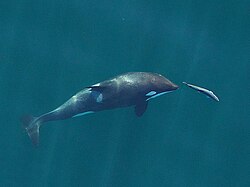






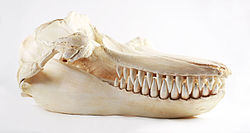





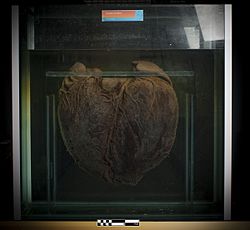
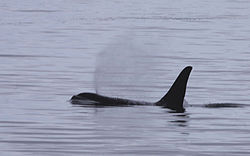





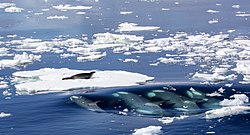











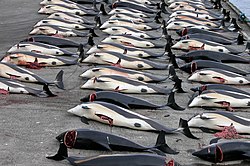








Relevantní články
KytovciKytovci (Cetacea) jsou podskupina (infrařád) sudokopytníků přizpůsobených k životu v moři. Jejich sesterskou skupinou jsou hrochovití. Kvůli výrazným anatomickým a fyziologickým adaptacím na vodní způsob života je jejich evoluční souvislost se suchozemskými savci dosti zastřená a donedávna byli považováni za samostatný řád. Mezi jejich nejnápadnější znaky související s přechodem do vody patří přeměna předních končetin v ploutve a vymizení zadních končetin, vznik horizontální (vodorovné) ocasní ploutve, která je hlavním orgánem pohybu, ztráta srsti, ztráta vnějšího ucha, získání hydrodynamického vřetenovitého tvaru těla a další. Typicky savčím projevem je jejich potřeba dýchat vzduch. Někteří kytovci sice mohou pod vodou vydržet i přes dvě hodiny, ale nakonec se nadechnout musí. Nozdry jsou posunuty v podstatě na temeno hlavy, lebka je touto tzv. teleskopizací oproti lebce jiných savců silně modifikovaná. .. pokračovat ve čtení
